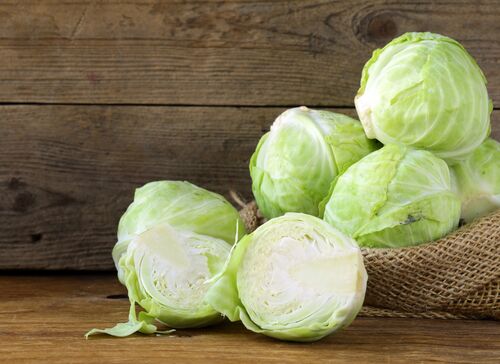Growing and Sowing White Cabbage

White cabbage, like pointed cabbage, red cabbage and savoy cabbage, is a head cabbage and takes a very long time to form. Like other headed cabbages, except pointed cabbage, it is not easy to grow. White cabbage has a mild cabbage flavour and can be used in many dishes. It can be stored for a long time after harvest, in a cool, dry place. White cabbage is also often used to make ‘Sauerkraut‘.
Growing your own white cabbage from seeds
White cabbage belongs to the cruciferous family and is a head cabbage. This means that the cabbage forms a kind of head because the leaves grow tightly together. As the name suggests, the cabbage is white on the inside, the outer leaves are light green. Head cabbages are biennial. In the first year the head is formed, in the second year it falls apart and long flower stems arise up to 2 meters high. It is a relatively difficult to grow cabbage variety, is very healthy and versatile. Because it easily absorbs other flavours, it can be combined well in numerous dishes.
Direct to the White Cabbage Seeds >
Sowing and planting white cabbage
White cabbage can be sown at different times, depending on when you want to harvest. Always keep a planting distance of at least 60 x 60 cm. For an early harvest, pre-sowing can be done in February and March, indoors or under glass. The plants can then be planted out in March or April and harvested in the summer.
For summer cultivation, white cabbage can be sown outdoors from mid-March to May. If necessary, thin out the plants a bit. Harvesting can then be done in the autumn. White cabbage can also be sown in September or October, under glass or in a greenhouse, in order to be able to plant out early in the spring of the following year. This gives the plants a head start and they can be harvested early, in spring.
To do so it is important that the plants are in a sunny spot, which can easily be covered if it gets too cold. A cold greenhouse is also suitable for this. This is also called winter-grown and can be done with many types of cabbage. Make sure the variety is suitable for this. In this way, the vegetable garden is also used in the winter months.
Position and soil
White cabbage likes a sunny spot in the garden and is very demanding as regards the soil. The soil must be fertile and firm and not dry out quickly. If necessary, the soil can be enriched with compost. Do not put cabbages in the same place more than 6 years, but alternate. Since cabbage plants like to be eaten by, for example, pigeons, caterpillars and snails, it is advisable to cover the plants with mesh or garden netting.
How to care for your white cabbage plants
White cabbage does not like drought, so water regularly, especially in hot weather. Occasional feeding is important, the cabbage grows slowly and needs a lot of nutrients. Fertilize also if the cabbages are growing poorly. With a shortage of nutrients or water there is a chance that the cabbages will burst open.
When and how to harvest white cabbage?
This depends on when it was sown. The cabbage can be harvested when it is the desired size and feels firm. Do pay attention to the weather forecast, if it rains a lot there is a chance that the cabbage will crack. In case of small cracks, harvest immediately. If the cabbage does crack, it will still be edible for a short time.
How to preserve white cabbage
White cabbage can be kept for a few months in a dry, cool place.
It can also be frozen, but first cut, wash and blanch it. In addition, white cabbage can be made into sauerkraut.
Is white cabbage healthy?
White cabbage is very healthy and contains a lot of vitamins C, K, B11, among other things. It also contains a lot of fiber and minerals. Use only the inner leaves, the outer ones are quite tough and also contain less nutrients.
White cabbage seeds in our collection
In our range, we have several varieties of white cabbage, including an organic one and one suitable for winter cultivation.
Tips to grow white cabbage
- Make use of a cabbage collar to deter cabbage root fly. It can no longer lay eggs on the cabbage leaves because of the collar.
- Cover the young plants with nets to prevent pigeons from eating them.



